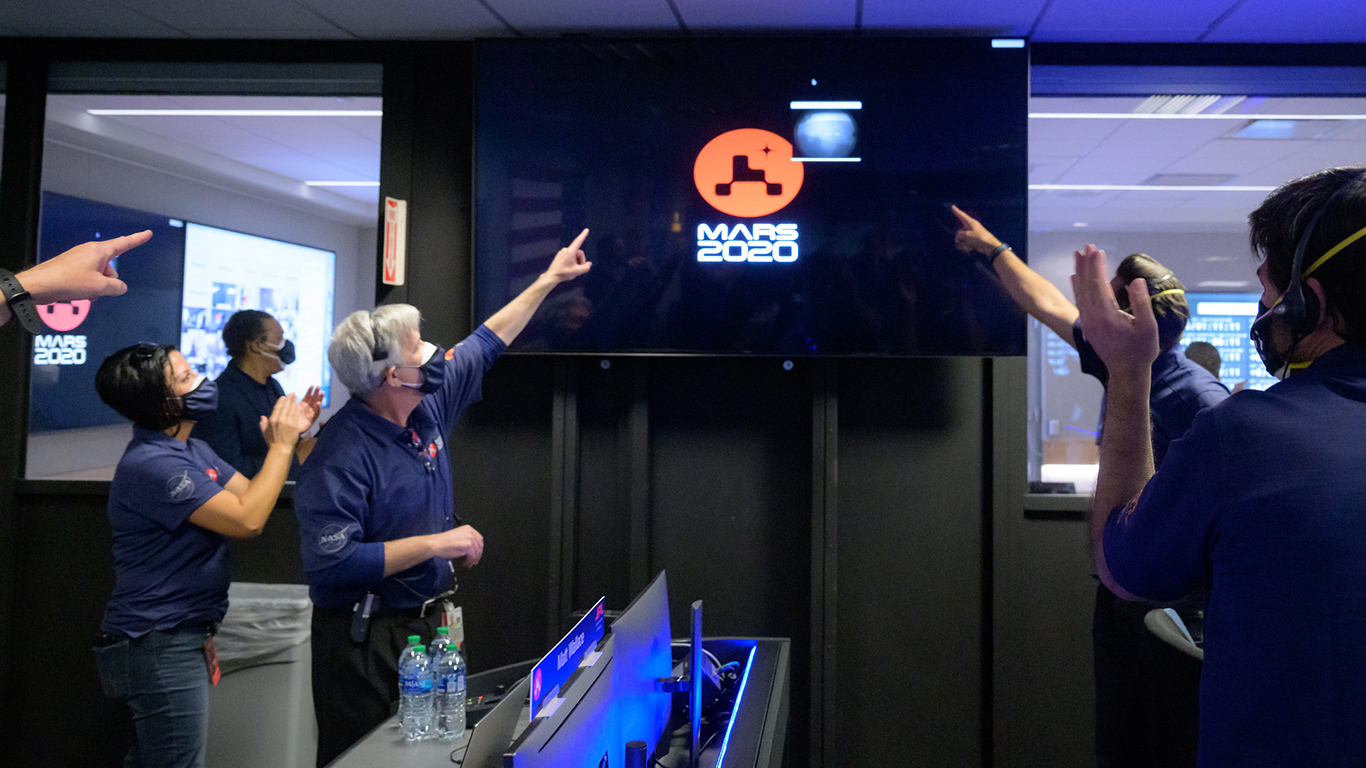
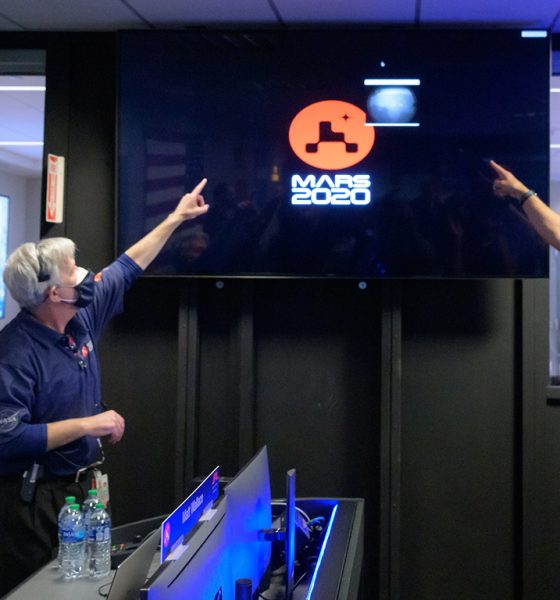
News
NASA aces most challenging Mars rover landing to date
After a nearly 300 million mile (480 million kilometer), seven-month-long journey, the world watched as NASA’s Mars 2020 Perseverance mission successfully completed the most challenging and precise landing the agency has ever attempted on Thursday (Feb. 18). Perseverance is NASA’s fifth rover and overall ninth mission to successfully land on the Red Planet.
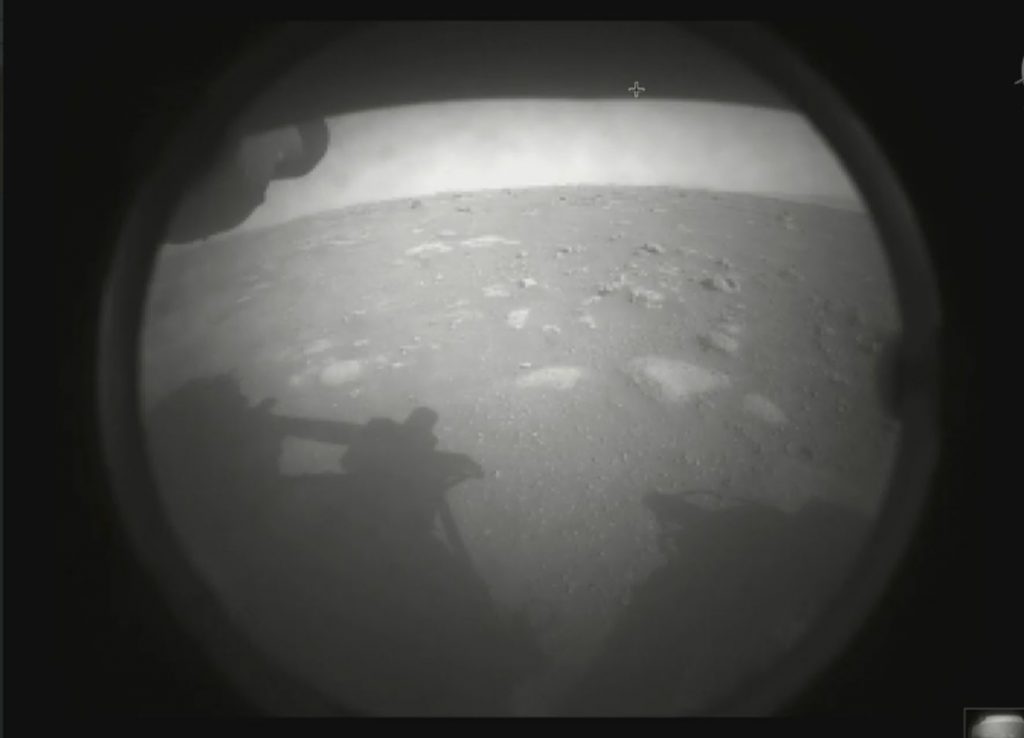
On Thursday afternoon, the alien invader punched through the relatively thin Martian atmosphere streaking across the sky at a blazing 12,100 mph (19,500 kph). Then it shed a few layers, deployed the largest-ever supersonic parachute, and slowed down just enough to use a rocket-propelled crane to drop an autonomous, nuclear-powered, robotic astrobiologist called Perseverance on the surface of Mars.
Flawlessly completing the entry, descent, and landing sequence of its mission to land in Mars’ hostile Jezero Crater, NASA’s Mars 2020 Perseverance mission officially marked the completion of its interplanetary travel phase and began its mission to collect evidence of ancient, microbial Martian life.
Getting to Mars
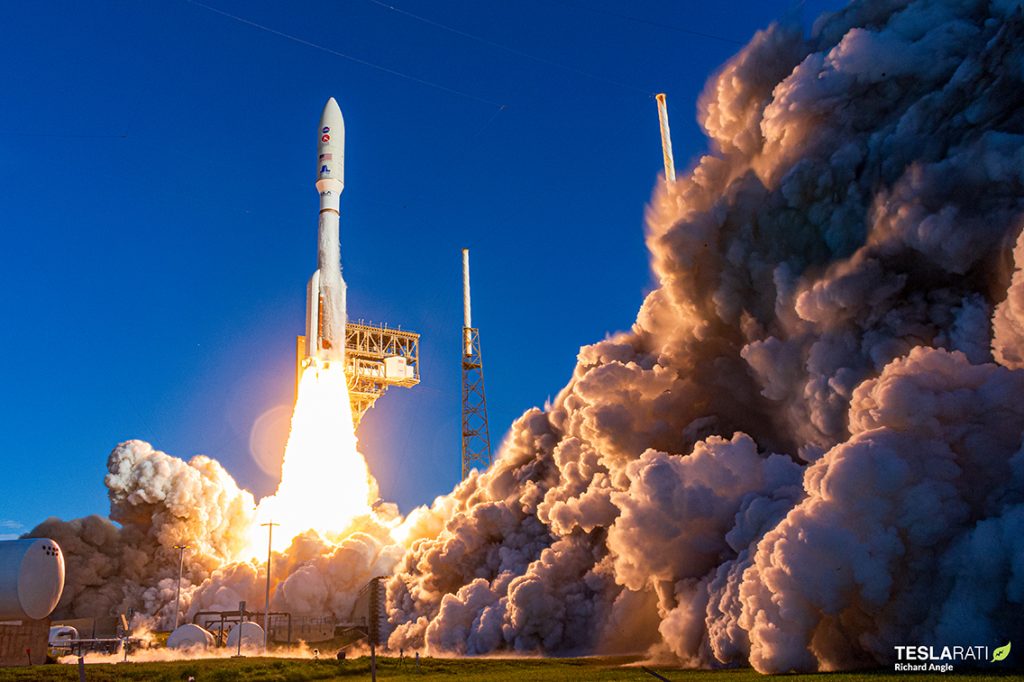
On July 30, 2020, NASA’s Mars 2020 Perseverance mission launched aboard a United Launch Alliance Atlas V 541 rocket from Space Launch Complex 41 at Cape Canaveral Space Force Base. Aboard that rocket was NASA’s most ambitious Mars mission to date. The launch phase of the mission suffered a few minor delays ultimately shifting the launch date from July 18, 2020 to July 30, 2020. However, ULA’s Atlas V first stage rocket and Centaur upper stage delivered NASA’s Mars 2020 Perseverance mission into such an accurate trajectory that the 2,260 lb (1,025 kg) rover landed on its specified February 18 landing date despite the delays in the launch timeline.
In total, three missions to Mars – China’s Tianwen-1, the United Arab Emirates Hope Probe, and NASA’s Perseverance – left Earth in the summer of 2020. All three missions targeted to leave Earth prior to August to best take advantage of the minimal distance between the planets during what is called opposition. The opposition between Earth and Mars only occurs once every 22 months. If the Perseverance mission had missed its launch date it would’ve had to wait until 2022 for a chance to travel to the Red Planet.
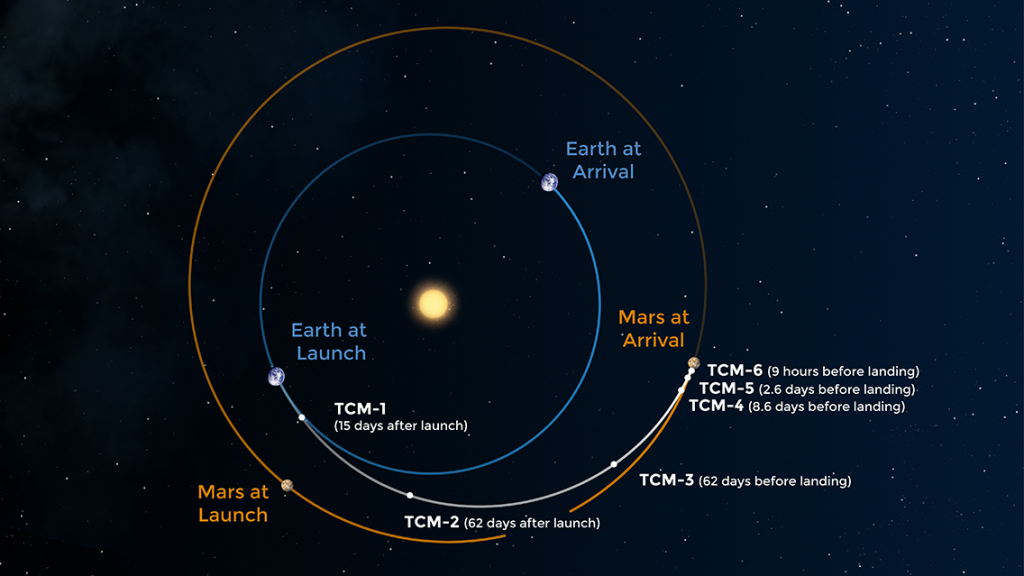
Entry, Descent, and Landing – a controlled disassembly
As Perseverance descended into the Martian atmosphere the Cruise Phase – hardware that propelled the spacecraft through space for seven months – was jettisoned. The Perseverance rover safely tucked inside the aeroshell and protected by a robust heat shield soared through the thin Martian atmosphere enduring an extreme amount of friction that produced heat energy that reached up to 2,370 degrees Fahrenheit (about 1,300 degrees Celsius).
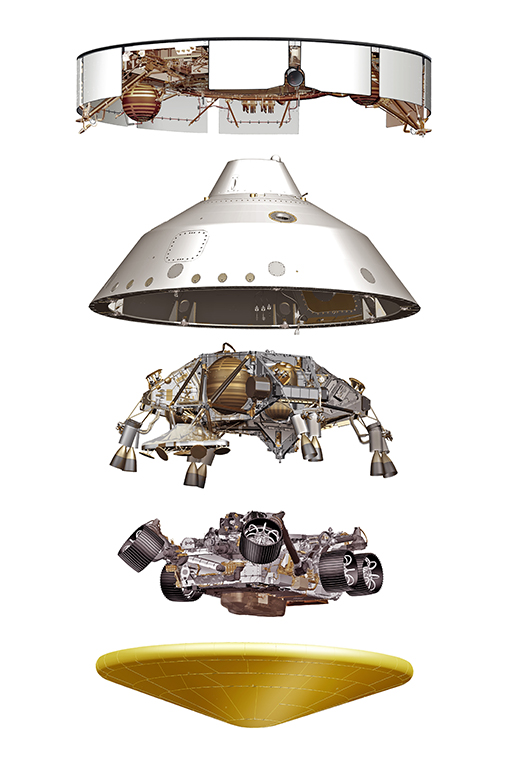
Once through the period of peak heating the heat shield was jettisoned exposing Perseverance to the Martian environment for the first time. Then about 7 miles (11 kilometers) from the surface the largest supersonic parachute NASA has ever sent to another planet – 70.5 feet (21.5 meters) in diameter – was deployed drastically slowing the spacecraft.
While still descending, the controlled descent module – called the sky crane – separated from the backshell about 1.3 miles (2.1 kilometers) above the surface to free-fly in the Martian atmosphere. The descent module used a new landing technology called Terrain-Relative Navigation used a constant stream of visual input and guidance collected from the Vision Compute Element and Rover Compute Element to determine the safest reachable landing site.
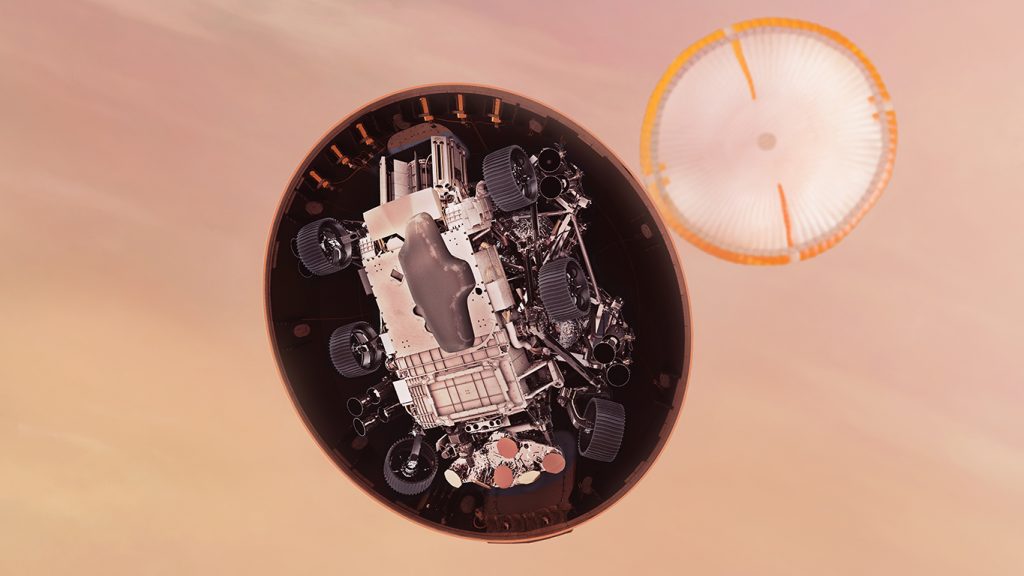
The throttleable rockets on the powered descent module steered the rover to its landing spot in Mars’ Jezero Crater and slowed to approximately 1.7 mph (2.7 kph) about 66 feet (20 meters) above the Martian surface. Perseverance was then lowered using a system of Nylon cords which were autonomously severed upon touchdown. The final stage of the controlled disassembly was for the sky crane to throttle its rockets back up and fly away for a crash landing a safe distance from the rover.
Ultimately, the Perseverance rover landed about a kilometer south of the intended delta of the Jezero Crater.
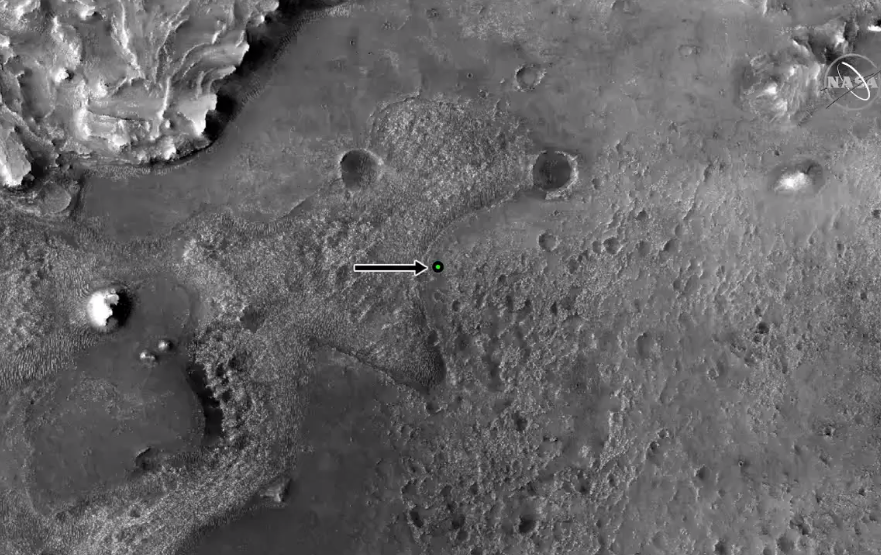
Perseverance made it to Mars, now what?
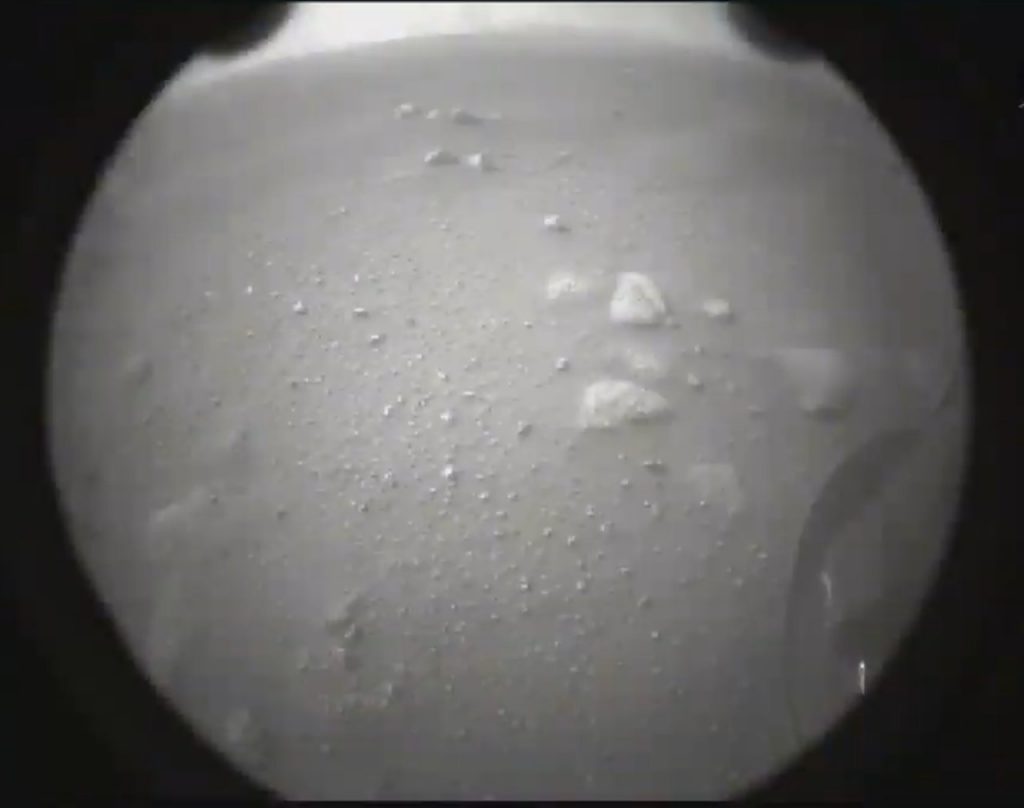
Getting to Mars was only the first of many milestones that Perseverance is expected to achieve during its projected one Mars year-long mission – about 687 Earth days. Now that the rover has touched down the science will begin.
First and foremost once Perseverance stretched its legs, so to speak, the first event took place just minutes after landing. Perseverance captured photos of the Martian surface with a pair of engineering cameras called Hazard Cameras mounted to the front and back of the rover.
The upgraded Navigation and Hazard cameras feature the capability to capture imagery of the Martian surface in 20 megapixel high-definition resolution for the first time. In the coming days, more images will be relayed back to Earth taken with the rover’s Navigation cameras and Mastcam-Z.

Once on Mars, the control of the Perseverance rover was transitioned from NASA JPL’s EDL team to the Perseverance Surface team. The Surface Phase of the Mars 2020 mission – or the phase of the mission that consists of the four main science objectives – began about twenty minutes after the touchdown.
Perseverance was sent to Mars to determine whether life ever existed on Mars, characterize the climate, characterize the geology, and prepare for the eventual human exploration of Mars. To achieve these massive science goals, the robotic astrobiologist was sent with an impressive suite of scientific research tools. Over the next 30 Martian days – called sols – the rover will begin to unfurl and begin testing the various pieces of hardware in preparation for exploring the delta of Jezero Crater.

Deploying the stowaway
Perseverance not only took a roving science lab to Mars, but it also took the first rotorcraft helicopter to be deployed to another planet dubbed Ingenuity. Ingenuity is a small double-bladed rotorcraft weighing only about 4 pounds (1.8 kilograms).
After the initial 30 Ssls of stretching its legs, Perseverance will travel a short distance to find a flat area of the Martian surface to deploy the Ingenuity helicopter. Once deployed, the Ingenuity team will have a technology demonstration window of approximately 30 sols to complete the first flight test of Ingenuity – the first time powered, controlled flight will be attempted on another planet.
Landing is just the beginning

As exciting as landing on Mars was, it is only the beginning for the Mars 2020 Perseverance rover. The nuclear-powered astrobiology robot will spend the next Martian year excavating the surface of a very rich delta in the Jezero crater searching for the first evidence of ancient, microbial life.
Even more exciting is that Perseverance is only the first phase of a larger mission called the Mars Sample Return mission that will someday bring the excavated samples that Perseverance collects back to Earth in a joint effort between NASA and the European Space Agency.
Although the Perseverance mission is only intended to last one Martian year, Perseverance has the capacity to extend its mission to nearly 15 years thanks to its power source, a Multi-Mission Radioisotope Thermoelectric Generator (MMRTG) which produces a steady stream of electricity provided by the radioactive decay of plutonium-238. Perseverance could potentially outlast all of NASA’s other Mars missions.

News
Tesla FSD fleet is nearing 7 billion total miles, including 2.5 billion city miles
As can be seen on Tesla’s official FSD webpage, vehicles equipped with the system have now navigated over 6.99 billion miles.

Tesla’s Full Self-Driving (Supervised) fleet is closing in on almost 7 billion total miles driven, as per data posted by the company on its official FSD webpage.
These figures hint at the massive scale of data fueling Tesla’s rapid FSD improvements, which have been quite notable as of late.
FSD mileage milestones
As can be seen on Tesla’s official FSD webpage, vehicles equipped with the system have now navigated over 6.99 billion miles. Tesla owner and avid FSD tester Whole Mars Catalog also shared a screenshot indicating that from the nearly 7 billion miles traveled by the FSD fleet, more than 2.5 billion miles were driven inside cities.
City miles are particularly valuable for complex urban scenarios like unprotected turns, pedestrian interactions, and traffic lights. This is also the difference-maker for FSD, as only complex solutions, such as Waymo’s self-driving taxis, operate similarly on inner-city streets. And even then, incidents such as the San Francisco blackouts have proven challenging for sensor-rich vehicles like Waymos.
Tesla’s data edge
Tesla has a number of advantages in the autonomous vehicle sector, one of which is the size of its fleet and the number of vehicles training FSD on real-world roads. Tesla’s nearly 7 billion FSD miles then allow the company to roll out updates that make its vehicles behave like they are being driven by experienced drivers, even if they are operating on their own.
So notable are Tesla’s improvements to FSD that NVIDIA Director of Robotics Jim Fan, after experiencing FSD v14, noted that the system is the first AI that passes what he described as a “Physical Turing Test.”
“Despite knowing exactly how robot learning works, I still find it magical watching the steering wheel turn by itself. First it feels surreal, next it becomes routine. Then, like the smartphone, taking it away actively hurts. This is how humanity gets rewired and glued to god-like technologies,” Fan wrote in a post on X.
News
Tesla starts showing how FSD will change lives in Europe
Local officials tested the system on narrow country roads and were impressed by FSD’s smooth, human-like driving, with some calling the service a game-changer for everyday life in areas that are far from urban centers.

Tesla has launched Europe’s first public shuttle service using Full Self-Driving (Supervised) in the rural Eifelkreis Bitburg-Prüm region of Germany, demonstrating how the technology can restore independence and mobility for people who struggle with limited transport options.
Local officials tested the system on narrow country roads and were impressed by FSD’s smooth, human-like driving, with some calling the service a game-changer for everyday life in areas that are far from urban centers.
Officials see real impact on rural residents
Arzfeld Mayor Johannes Kuhl and District Administrator Andreas Kruppert personally tested the Tesla shuttle service. This allowed them to see just how well FSD navigated winding lanes and rural roads confidently. Kruppert said, “Autonomous driving sounds like science fiction to many, but we simply see here that it works totally well in rural regions too.” Kuhl, for his part, also noted that FSD “feels like a very experienced driver.”
The pilot complements the area’s “Citizen Bus” program, which provides on-demand rides for elderly residents who can no longer drive themselves. Tesla Europe shared a video of a demonstration of the service, highlighting how FSD gives people their freedom back, even in places where public transport is not as prevalent.
What the Ministry for Economic Affairs and Transport says
Rhineland-Palatinate’s Minister Daniela Schmitt supported the project, praising the collaboration that made this “first of its kind in Europe” possible. As per the ministry, the rural rollout for the service shows FSD’s potential beyond major cities, and it delivers tangible benefits like grocery runs, doctor visits, and social connections for isolated residents.
“Reliable and flexible mobility is especially vital in rural areas. With the launch of a shuttle service using self-driving vehicles (FSD supervised) by Tesla in the Eifelkreis Bitburg-Prüm, an innovative pilot project is now getting underway that complements local community bus services. It is the first project of its kind in Europe.
“The result is a real gain for rural mobility: greater accessibility, more flexibility and tangible benefits for everyday life. A strong signal for innovation, cooperation and future-oriented mobility beyond urban centers,” the ministry wrote in a LinkedIn post.
News
Tesla China quietly posts Robotaxi-related job listing
Tesla China is currently seeking a Low Voltage Electrical Engineer to work on circuit board design for the company’s autonomous vehicles.

Tesla has posted a new job listing in Shanghai explicitly tied to its Robotaxi program, fueling speculation that the company is preparing to launch its dedicated autonomous ride-hailing service in China.
As noted in the listing, Tesla China is currently seeking a Low Voltage Electrical Engineer to work on circuit board design for the company’s autonomous vehicles.
Robotaxi-specific role
The listing, which was shared on social media platform X by industry watcher @tslaming, suggested that Tesla China is looking to fill the role urgently. The job listing itself specifically mentions that the person hired for the role will be working on the Low Voltage Hardware team, which would design the circuit boards that would serve as the nervous system of the Robotaxi.
Key tasks for the role, as indicated in the job listing, include collaboration with PCB layout, firmware, mechanical, program management, and validation teams, among other responsibilities. The role is based in Shanghai.
China Robotaxi launch
China represents a massive potential market for robotaxis, with its dense urban centers and supportive policies in select cities. Tesla has limited permission to roll out FSD in the country, though despite this, its vehicles have been hailed as among the best in the market when it comes to autonomous features. So far, at least, it appears that China supports Tesla’s FSD and Robotaxi rollout.
This was hinted at in November, when Tesla brought the Cybercab to the 8th China International Import Expo (CIIE) in Shanghai, marking the first time that the autonomous two-seater was brought to the Asia-Pacific region. The vehicle, despite not having a release date in China, received a significant amount of interest among the event’s attendees.









